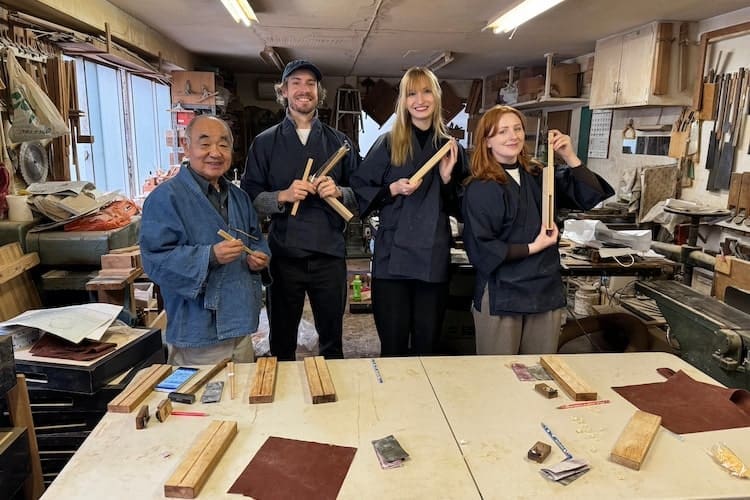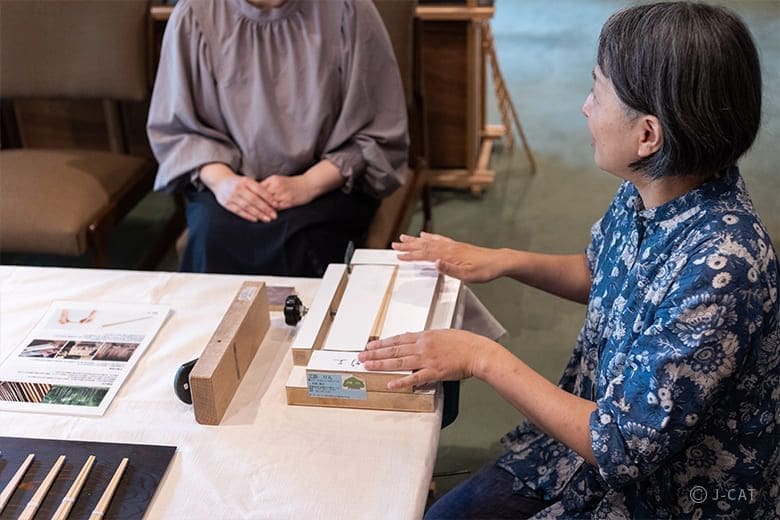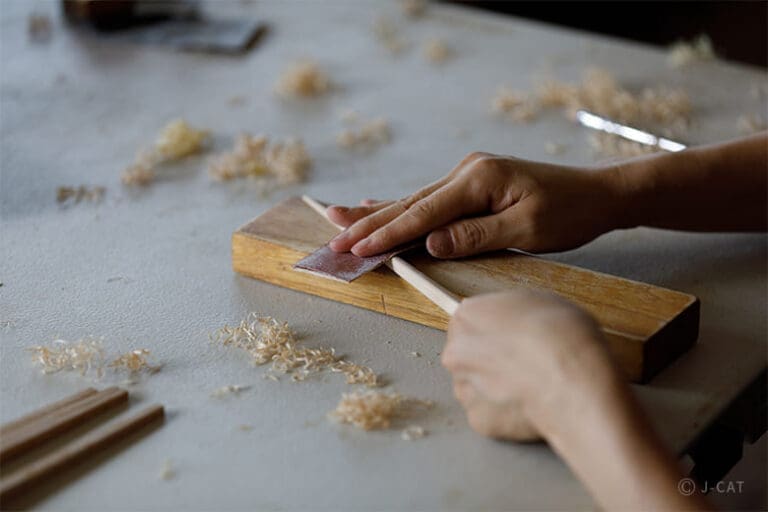Bringing chopsticks back home from Japan is a solid souvenir choice. Practical, traditional, and straight from the source. You could grab a pair for ¥200 at any Japanese store like Daiso or Don Quijote. Or, you could take it up a notch and make your own at a chopstick-making workshop. It’s a great option if:
- You like hands-on activities.
- But you’re not too advanced (e.g. a professional woodworker might find it too simple).
- You want a fun experience with the people you’re traveling with (and yes, making chopsticks is pretty kid-friendly too).
In this post you’ll find out more about how chopsticks are made, and the best places in Tokyo and Kyoto where you can make your own.
Note: in 2025 the number of chopstick workshops have sharply increased. I’ve updated this post with to reflect that.
What Chopsticks Really Mean in Japanese Culture
Chopsticks are utensils to eat, yes, but they’re also one of the cultural icons representing the history and traditions of Japan. They originated more at least 2000 years ago in China and were first only used as cooking utensils, but have evolved in design and utility to what we know today.
They’re an integral part of the dining culture in East Asian countries, including Japan. If you eat with Japanese people and use chopsticks, you will probably even hear them complimenting your chopstick skills, proud that a foreigner can use their utensils with dexterity.
In fact, chopsticks are so integral to Japanese dining that they have their own set of customs and manners, known as “chopstick etiquette“. Making your own chopsticks is a fun way to connect to the Japanese culture while bringing a practical souvenir home.
How to Make Your Own Chopsticks: The Process
When it comes to making chopsticks, you first need to choose the type of wood. Popular options include bamboo, cypress, or oak. But there are many more, each offering its unique texture and aesthetic appeal.
After selecting your wood, the process generally involves 1. cutting it into shape, 2. sanding the surface, and finally, 3. applying a layer of protective coating or lacquer.
This activity is pretty beginner-friendly, but don’t think it will be easy. I actually almost transformed my chopsticks into toothpicks when I did it at Mogami Kogei workshop (this is the most authentic chopstick making experience in Japan. Read my review here)! Fortunately my instructor fixed my mistakes and I could leave with beautiful chopsticks.
Here is a video I made about this experience:
But even for those like me who are not good at manual work, participating in a chopstick-making workshop allows you to learn these skills from experienced artisans while giving you the opportunity to create chopsticks that are uniquely yours.
This hands-on approach to embracing Japanese culture doesn’t stop with chopsticks. If you’re intrigued by traditional craftsmanship, explore how you can also make your own knife in Japan, another way to connect with Japan’s deep artisanal culture.
Where Can You Make Your Own Chopsticks in Tokyo?
I’ve been working in the Japan travel industry since 2019 and before 2025, I had only seen a handful of chopstick making workshops in all Japan. Now the number of workshops have increased a lot and it’s not hard to find one in central Tokyo. I selected the best (and only consistently available) workshops where you can have a chopstick-making experience in Tokyo and around. I’ve ranked them from highest quality, to more touristy experiences:
| Workshop Name | Location | Price | Unique Features | Reservation Link |
| Mogami Kogei | Kuramae, Tokyo | ¥30,000/person ($197/person) | ✅ 100% private (no mixed group) ✅ An interpreter will accompany you ✅ Duration: 1h30 minutes ✅ Ideally located in central Tokyo ✅ Learn from master craftsman Yutaka Mogami, one of the only one in Japan ✅ Lesson and talk on the history and craft of Edo sashimono woodworking ✅ Get a handmade chopstick box made in high quality Aizu paulownia wood to take your chopsticks home | Wabunka |
| Kakehashi | Sasazuka, Tokyo (West Tokyo, short train ride from Shinjuku station) | ¥15,000/person ($100/person) | ⚠️ Group class (up to 6) ✅ Instructors are real artisans ✅ An English speaking guide will accompany you ✅ Duration: 1h30 minutes ✅ Optional lacquer coating experience | Viator |
| Chopstick Making Workshop with Artisan | Kuramae, Tokyo | ¥4,000/person ($26/person) | ⚠️ Group class ✅ Ideally located in central Tokyo ✅ English speaking instructors ⚠️ Duration: 30 minutes ✅ Engrave your chopsticks | Viator, GetYourGuide, or Klook |
| Shinjuku Chopsticks Making Class | Shinjuku, Tokyo | ¥5,000/person ($33/person) | ⚠️ Big group class (up to 32) ✅ Ideally located in Shinjuku ✅ English speaking instructors ⚠️ Store staff are not actual woodworking artisans ✅ Engrave your name in Japanese ✅ Duration: 1 hour ⚠️ Can feel like a touristy experience ⚠️ Look at photos from reviews as provider’s photos seem AI generated | Viator, GetYourGuide, or Klook |
| Chopstick Making Workshop in Ginza | Ginza, Tokyo | ¥3,980/person ($26/person) + additional fees based on options | ⚠️ Group class (up to 8) ✅ Ideally located in central Tokyo ✅ English speaking instructors ⚠️ Store staff are not actual woodworking artisans ✅ Duration: 1 hour ✅ Choose from 16 different types of wood (additional fee for 13 of them) ✅ Engrave your chopsticks (additional fee) ⚠️ Can feel like a touristy experience | GetYourGuide |
| Karaki Mokko | Kawagoe, Saitama (1h from Tokyo) | ¥1,650/person ($11/person) + additional fees based on the wood chosen to make the chopsticks | ⚠️ English instructions are available, but staff may have limited English proficiency ✅ Choose from 16 different types of wood ⚠️ Slightly far from Tokyo ⚠️ Store staff are not actual woodworking artisans ⚠️ Duration: 30 minutes ⚠️ Can feel like a touristy experience | Jalan (in Japanese only), or walk-in |
Quick note:
- Wabunka experiences are in a league of their own in terms of quality (with the pricing that comes with it).
- The three workshops priced ¥4,000 to ¥5,000 are very similar in both quality and contents. If you choose one of these, I recommend simply picking the most convenient option for you, such as the closest to your hotel. Be sure to check all the links I included, as one of the websites might occasionally run a promotion that lowers the price by 10-20%.
- The second workshop at ¥15,000/person in Sasazuka can be a good balance if you don’t have the budget for Wabunka, but would still like to avoid touristy experiences.
- The last one in Kawagoe is only interesting if you’ve already planned to go to Kawagoe for a day trip.
My recommendation:
If you have the budget, go with Mogami Kogei. I went there and I absolutely loved it. This is by far the best chopstick-making experience you will find in Tokyo, and even in Japan.
It is more expensive, but having this private experience with a master craftsman who dedicated his life to his art is definitely worth it. Here is a video from the Wabunka YouTube channel featuring master craftsman Mogami-san (owner of Mogami Kogei workshop) who will be your teacher during this experience:
You will also be accompanied by an interpreter, so that you can ask questions and communicate with Mogami-san (who is one of the ten last Edo Sashimono woodworking craftsmen in Tokyo) on a whole different level. And as a plus, Mogami Kogei is located in central Tokyo.
You can read my full report about this experience here.
This workshop is offered by Wabunka. If you’re looking for unique and non-touristy experiences in Japan, check out their website. They offer the most authentic experiences available out there. (Disclaimer: I’ve worked with them as part of my job in the travel industry, so I know them personally. I can vouch for their expertise and professionalism).

If you’re on a budget and are not worried about going through a Japanese website for the booking process (or just walk-in the store and book your 30-minute session), then go for Karaki Mokko in Kawagoe. Honestly, it won’t be as memorable (you will be in a crowded shop and a staff person will give you quick basic instructions) but you’ll still have fun making your own handmade personalized chopsticks. Be aware that English may be limited.

A word on Kawagoe though – it is a city north-west of Tokyo (it is actually in Saitama, a neighboring prefecture) that kept an old and traditional vibe. I wouldn’t recommend going just for the chopstick-making workshop, but Kawagoe is worth the day trip, especially if you’re not visiting Kyoto or other cities with a traditional district like Okayama or Kanazawa during your trip. Kawagoe is one hour away or less by train from most the major stations of Tokyo, and a one-way trip will cost you ¥600 to ¥800 depending on which station you’re starting from (but you’ll have to take the Tobu-Tojo line from Ikebukuro in any case to reach Kawagoe Station).
Where Can You Make Your Own Chopsticks in Kyoto?
Kyoto is a city rich with history of traditional crafts, and it offers a few chopstick-making workshops. Here are the workshops I’ve selected, in Kyoto and nearby cities. Note that apart from the first experience in this list, all the others have similar quality and contents:
| Workshop Name | Location | Price | Unique Features | Reservation Link |
| Takano Chikko | Nagaokakyo City, Kyoto | ¥33,000/person ($210/person) | ✅ Private group (only your group) ✅ An interpreter will accompany you ✅ Duration: 1h30 minutes ✅ Make bamboo chopsticks ✅ Visit a bamboo garden and learn from a professional bamboo harvester ✅ Eat Japanese confectionery and drink matcha tea in artisanal bamboo dishware ✅ Take home your chopsticks and a chopstick rest made of bamboo | Wabunka |
| Nara Chopstick-Making Workshop | Nara (1h from Kyoto) | ¥6,500/person ($42/person) | ⚠️ Group class (✅ only up to 4) ✅ English speaking instructors ✅ Duration: 1 hour ⚠️ Located in Nara, not Kyoto | GetYourGuide |
| Yokoyama Bamboo Store | Kamigyo, Kyoto | ¥9,900/person ($66/person) | ⚠️ Group class (up to 15) ✅ Available in English ✅ Ideally located in central Kyoto ✅ Duration: 2 hours ✅ Get a case to take your chopsticks home | Activity Japan (machine-translated English) |
| Gion Chopstick Making Workshop | Gion, Kyoto | ¥6,000/person ($66/person) | ⚠️ Big group class (up to 32) ✅ Ideally located in a historic district of Kyoto ✅ English speaking instructors ⚠️ Store staff are not actual woodworking artisans ✅ Engrave your name in Japanese ✅ Duration: 1 hour ⚠️ Can feel like a touristy experience ⚠️ Look at photos from reviews as provider’s photos seem AI generated | Viator, or GetYourGuide |
| Marumasu-Nishimuraya | Nakagyo Ward, Kyoto | ¥3,500/person ($22/person) | ⚠️ Group class (up to 8) ✅ Available in English ✅ Ideally located in central Kyoto ✅ Duration: 2 hours ✅ Decorate a small chopstick bag to take your chopsticks home | Wamazing |
| Kyomachiya Workshop Waraku | Higashiyama, Kyoto | ¥3,300/person ($21/person) | ⚠️ Group class (up to 15) ⚠️ English might be limited ✅ Ideally located in a historic district of Kyoto ✅ Duration: 1 hour ✅ The workshop is in a 120 years old Machiya (traditional wooden townhouse) ✅ Located in traditional district Higashiyama | Activity Japan (machine-translated English) |
My recommendation:
If your budget allows, Takano Chikko offers the best experience by far. You’ll get to dive deep into the art of using bamboo as an artisanal material. It’s perfect if you’re interested in traditional craftsmanship, or want a real connection with Japanese artisans. This is again a Wabunka experience, so you can be sure it will be one of the highlights of your trip.

For more budget-friendly options, all the other experiences on this list are of similar quality.
The Nara chopstick-making workshop is the one I’d recommend, mainly for its small group setting. However, it only makes sense if you plan to visit Nara and have extra time during your day between feeding the deers in Nara Park. Otherwise, I suggest choosing whichever one appeals to you most. The experiences located in Kyoto’s traditional districts might provide the atmosphere you’re imagining.
Besides that, I recommend booking experiences available on Viator or GetYourGuide simply for ease of use. Their websites are easy to navigate, fully in English, with clear information and straightforward cancellation and refund policies if you need them.
Frequently Asked Questions (FAQ)
Can Kids Participate in Chopstick-Making Workshops?
Absolutely, chopstick-making can be a great family activity. However, it’s best to double-check age restrictions or guidelines when you book.
Is There a Dress Code for These Workshops?
Generally, there’s no dress code, but comfortable and casual attire is usually recommended. Note that you will probably have wood particles or dust on you by the end of the experience.
How Long Does a Typical Chopstick-Making Class Last?
Most workshops last between one to two hours. The duration can vary based on how guided the activity is and the pace of the class.
Do I Need to Book in Advance?
While some workshops may accept walk-ins, it’s generally advisable to book in advance.
Can I Personalize My Chopsticks?
Yes, many workshops allow you to personalize your chopsticks, either by carving initials, adding decorations, engraving your own chopstick box, or at least choosing specific types of wood.
The Bottom Line
Making your own chopsticks is such a cool, off-the-beaten-path experience, and you get a functional souvenir to bring home. Only downside is, you’ll want to eat sushi all the time back home just so that you can show off your handmade chopsticks!

